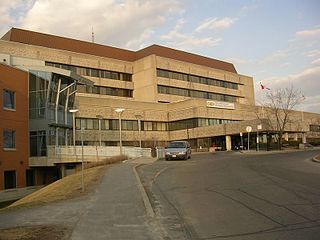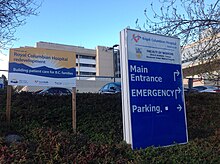
CHEO is a pediatric health-care and research centre located in Ottawa, Ontario, Canada. CHEO is also a tertiary trauma centre for children in Eastern Ontario, Nunavut, Northern Ontario and the Outaouais region of Quebec and one of only seven Level I trauma centres for children in Canada. It is affiliated with The Ottawa Hospital and the University of Ottawa, and is funded by the provincial Government of Ontario. CHEO first opened its doors on May 17, 1974, and is located at 401 Smyth Road, Ottawa, Ontario.

Monash Medical Centre (MMC) is a teaching hospital in Melbourne, Australia. It provides specialist tertiary-level healthcare to the Melbourne's south-east.
Chinook Regional Hospital is the district general hospital for the City of Lethbridge and Southern Alberta, and offers many of the health care services for Alberta Health Services. The hospital services a population of over 150,000 and is supported by the Chinook Regional Hospital Foundation.
The Fraser Health Authority (FHA) is one of five publicly funded health authorities into which the Canadian province of British Columbia (BC) is divided. It is governed by the provincial Health Authorities Act.

Montreal Children's Hospital is a children's hospital in Montreal, Quebec, Canada. Founded in 1904, it is affiliated with the McGill University Health Centre (MUHC) and McGill University, Faculty of Medicine.

Adventist HealthCare Shady Grove Medical Center is a 266-licensed bed acute care facility located in Rockville, Maryland. Shady Grove Medical Center provides a range of health services to the community such as high-risk obstetrical care, cardiac and vascular care, oncology services, orthopedic care, surgical services and pediatric care. Opened in 1979 as Shady Grove Adventist Hospital, Shady Grove Medical Center operates as part of Adventist HealthCare, a health-care delivery system that includes hospitals, home health agencies and other health-care services. Adventist HealthCare is headquartered in Gaithersburg, Maryland.

The Royal Victoria Regional Health Centre is an Advanced Level II facility with stroke designation, serving the needs of the population of the City of Barrie and the surrounding area. The facility is located at 201 Georgian Drive in Barrie, Ontario, Canada. The CEO is Gail Hunt. As of 2017, the hospital operated on a $340 million annual budget.

Surrey Memorial Hospital (SMH) is a publicly funded hospital owned and operated by Fraser Health in the city of Surrey, British Columbia, Canada, adjacent to King George Boulevard.

British Columbia Children's Hospital is a medical facility located in Vancouver, British Columbia, and is an agency of the Provincial Health Services Authority. It specializes in health care for patients from birth to 16 years of age. It is also a teaching and research facility for children's medicine. The hospital includes the Sunny Hill Health Centre, which provides specialized services to children and youth with developmental disabilities aged birth to 18 years.

University of Missouri Health Care is an American academic health system located in Columbia, Missouri. It's owned by the University of Missouri System. University of Missouri Health System includes five hospitals: University Hospital, Ellis Fischel Cancer Center, Missouri Orthopedic Institute and University of Missouri Women's and Children's Hospital — all of which are located in Columbia. It's affiliated with Capital Region Medical Center in Jefferson City, Missouri. It also includes more than 60 primary and specialty-care clinics and the University Physicians medical group.

The Timpanogos Regional Hospital is a hospital located in Orem, Utah, United States. It is owned and operated by MountainStar Healthcare. The hospital was opened in 1998 as a unit of Columbia Hospital Corporation.

Atrium Health Floyd is a system of health care providers serving Northwest Georgia and Northeast Alabama since 1942. Located in Rome, Georgia, it is Floyd County’s largest employer with over 3,400 employees. It is a part of the Atrium Health system.
Richmond Hospital (RH) is a general hospital in Richmond, British Columbia, Canada. The Vancouver Coastal Health Authority (VCH) is responsible for Richmond Health Services and Richmond Hospital.
The Canadian Perinatal Network (CPN) is made up of Canadian researchers who collaborate on research issues relating to perinatal care. The network commenced in September 2005, and includes members from 25 tertiary perinatal units. CPN will enable health care professionals, researchers, and administrators to participate actively in clinical, epidemiologic, health services, health policy, and informatics research aimed at improving the effectiveness and efficiency of perinatal care.

Peace Arch Hospital (PAH) is a 146-bed acute care facility, and Level IV trauma centre owned and operated by Fraser Health. The hospital is located at 15521 Russell Avenue, White Rock, British Columbia, Canada, and its catchment area includes South Surrey.

Burnaby Hospital, is a healthcare facility located in Burnaby, British Columbia, and operated by the Fraser Health Authority (FHA). One of the largest hospitals outside the City of Vancouver, it serves the communities of Burnaby and East Vancouver. A 314-bed primary and secondary care centre, patient care services include general surgery, orthopedic surgery, medicine, perinatal, neonatal ICU, critical care and emergency services.

Kaweah Health Medical Center is located in Visalia, California, United States and offers comprehensive health services including cardiac, vascular, colorectal, and general surgery, neurosurgery, oncology, mental health services, orthopedic surgery, adult and neonatal intensive care and pediatrics, and more. It is the largest hospital in Tulare County and Kings County, serving a population of more than 600,000. Kaweah Health is governed by an elected board of directors.
Lakeridge Health Ajax and Pickering is a hospital in Ajax, Ontario, Canada that is operated by Lakeridge Health. The hospital opened in 1954 as the Ajax and Pickering General Hospital.

Royal Inland Hospital is a medical facility located in Kamloops, British Columbia serving a catchment area of 225,000 km2.

Abbotsford Regional Hospital and Cancer Centre (ARHCC) is a 300-bed Canadian health care facility in the City of Abbotsford, British Columbia that houses the acute care Abbotsford Regional Hospital (ARH) operated by Fraser Health and the regional cancer facility operated by the BC Cancer Agency.




















